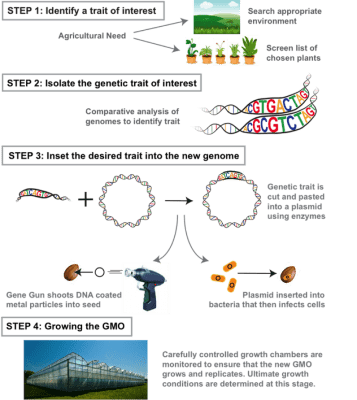GMO Technologies
GMO plants, also called transgenic plants, refer to plants that are altered by scientists using genetic engineering methods. A traditional and typical technique to create GMO plants involves several steps (Fig. 1): 1) choosing and isolating the coding sequence of a desirable trait gene; 2) constructing a fusion gene vector using the coding sequence and other necessary DNA elements such as promoter and terminator sequences, and also a selectable marker gene; 3) inserting the trait gene and selectable marker gene into a host plant genome. Inserting genes into the genome of a host plant can be accomplished with Agrobacterium- or biolistics-(‘gene gun’) mediated transformation. For Agrobacterium-mediated plant transformation, the T-DNA plasmid of Agrobacterium is the vector that hosts the trait gene and selectable marker gene. Agrobacterium containing the T-DNA plasmid can help insert these genes into the genome of a host plant that is susceptible to Agrobacterium infection. For the biolistic transformation, small gold or tungsten particles are coated with DNA of the trait gene and selectable marker gene and then bombarded into plant cells. Some DNA entering the nucleus can be integrated into the host plant genome. The biolistic method can be used on plants that are not susceptible to Agrobacterium infection. The following link is an updated summary of the FDA’s Inventory of Completed Biotechnology Consultations on GMO plants, available to the public:
http://www.accessdata.fda.gov/scripts/fdcc/index.cfm?set=Biocon

By Yi Li and Gerald Berkowitz, Professors, UConn Department of Plant Science and Landscape Architecture
Published October 3, 2017